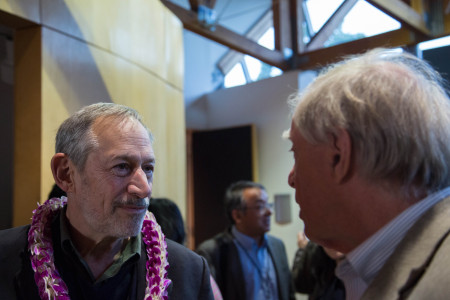Climate Services: Two conferences on two continents
By Adam Sobel
This post originally appeared on Sobel’s blog. Out this month is his new book, Storm Surge: Hurricane Sandy, Our Changing Climate, and Extreme Weather of the Past and Future.
I spent this past week in Darmstadt, Germany, for the Climate Symposium. This was a conference organized by EUMETSAT (one of the European space agencies) and the World Climate Research Program.
The conference had a couple of goals. Perhaps most prominent was to “ascertain critical objectives to be achieved with satellite-based climate information, and identify gaps in the current space-based component of the climate observing system” – in other words, help EUMETSAT decide what new satellite instruments to build and launch in the coming years. The idea here was to present the current state and future needs of climate science in order to determine how new satellite observations could help. The climate science was presented through the lens of WCRP’s new Grand Challenges. (I am involved directly in one of these, on Clouds, Circulation and Climate Sensitivity, and interacting with the leaders of another, on Understanding and Predicting Weather and Climate Extremes.)
Climate science justifies its funding largely on the basis of its benefit (real or potential) to society, and that justification was particularly explicit at this conference. A lot of the program was devoted to “Climate Services”. This term refers to entities and people whose jobs lie in between the physical science of climate and “users” of climate information, also known as “stakeholders”. Climate Services involves translating the information that climate science can provide into terms that will be most useful for specific human purposes. (In the US, NOAA tried a few years ago – at the instruction of President Obama – to create a National Climate Service, with a status analogous to the National Weather Service. Congress, much of which hates even the word “climate”, killed it.) In practice, Climate Services is about taking the time to learn what specific users’ needs are, teaching those users what climate information current science can and can’t provide, and packaging the information to make it easier for them to digest.
Most of what I know about Climate Services comes from the International Research Institute for Climate and Society (IRI) at Columbia, which has been providing climate services since well before I (or most other people) ever heard the term. I was initially hired at Columbia through the IRI, which came into being a couple of years before I arrived here in January 2000. The IRI, in turn, exists because of the work of Mark Cane.
In the 1980s, Mark and his then student Steve Zebiak (later to become a founding member, and then director of IRI) developed the first numerical model that was capable of predicting the El Niño/Southern Oscillation (ENSO) phenomenon. They demonstrated this by making a successful prediction of the 1986/87 event.
While ENSO occurs in the equatorial Pacific, it has influences on climate and weather across much of the earth. An El Niño, for example, typically causes drought in Australia, Indonesia, southern Africa, and northeast Brazil, wet weather in southern California and unusually clear weather in the Pacific Northwest, and fewer hurricanes in the Atlantic, among other changes. Cane and Zebiak realized that the forecast capability they had developed had the potential to make a positive difference to the lives of a substantial fraction of the planet’s population. By knowing something about how the upcoming season or two would be likely to differ from the usual, people and governments could plan ahead across many sectors of activity: agriculture, water, health.
The IRI was created to realize that potential, and has been working with countries around the world for over 15 years to that end. While the notion of Climate Services now is as much about long-term anthropogenic climate change as it is about interannual variability (a la ENSO), ENSO and the IRI were at the start of it as much as anything, and are still a critically important component.
Tomorrow – Monday October 20 – we will start The Tropics Rule, a Symposium Honoring Mark Cane’s Contribution to Climate Science. This will be a two-day event on the occasion of Mark’s 70th birthday, featuring a long list of distinguished scientists presenting new research and historical reflections on Mark’s long career of truly amazing scientific achievements. It will take place in Monell Auditorium, the physical home of the IRI, on the Lamont Campus.
So in summary, I got on a plane to fly to Germany for a conference where I heard about the present and future of Climate Services. Then I got back on a plane to fly home to attend another conference at my own institution, in honor of the scientist who, it is not a great exaggeration to say, invented the idea.


You must be logged in to post a comment.